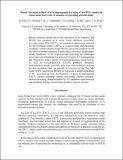Files in this item
Recent advances in Rh/CGO co-impregnated La0.20Sr0.25Ca0.45TiO3 anodes for solid oxide fuel cells : evaluation of upscaling and durability
Item metadata
| dc.contributor.author | Price, R. | |
| dc.contributor.author | Weissen, U. | |
| dc.contributor.author | Verbraeken, M. C. | |
| dc.contributor.author | Grolig, J. G. | |
| dc.contributor.author | Mai, A. | |
| dc.contributor.author | Irvine, J. T.S. | |
| dc.contributor.editor | Eguchi, K. | |
| dc.contributor.editor | Singhal, S. C. | |
| dc.date.accessioned | 2019-10-30T10:30:03Z | |
| dc.date.available | 2019-10-30T10:30:03Z | |
| dc.date.issued | 2019-09-08 | |
| dc.identifier | 262433250 | |
| dc.identifier | 9f5335a3-f51b-4668-ade2-b8ca3c95a2c7 | |
| dc.identifier | 85073213910 | |
| dc.identifier.citation | Price , R , Weissen , U , Verbraeken , M C , Grolig , J G , Mai , A & Irvine , J T S 2019 , Recent advances in Rh/CGO co-impregnated La 0.20 Sr 0.25 Ca 0.45 TiO 3 anodes for solid oxide fuel cells : evaluation of upscaling and durability . in K Eguchi & S C Singhal (eds) , Solid Oxide Fuel Cells 16, SOFC XVI . ECS Transactions , no. 1 , vol. 91 , Electrochemical Society, Inc. , pp. 1741-1750 , 16th International Symposium on Solid Oxide Fuel Cells, SOFC XVI , Kyoto , Japan , 8/09/19 . https://doi.org/10.1149/09101.1741ecst | en |
| dc.identifier.citation | conference | en |
| dc.identifier.isbn | 9781607685395 | |
| dc.identifier.issn | 1938-6737 | |
| dc.identifier.other | ORCID: /0000-0002-8394-3359/work/68280810 | |
| dc.identifier.uri | https://hdl.handle.net/10023/18803 | |
| dc.description | Funding: University of St Andrews and HEXIS AG; UK EPSRC grants: EP/M014304/1 “Tailoring of Microstructural Evolution in Impregnated SOFC Electrodes” and EP/L017008/1 “Capital for Great Technologies”. | en |
| dc.description.abstract | Recent research carried out at the University of St Andrews and HEXIS has focussed on a novel A-site deficient perovskite: La0.20Sr0.25Ca0.45TiO3 (LSCTA-) as a potential replacement material for the Ni-based cermet. LSCTA- is a mixed ionic and electronic conductor, which exhibits a high effective electrical conductivity for this class of limited conductivity perovskite, allowing a single-phase anode 'backbone' to be employed and removing the challenges associated with utilisation of a structural Ni phase. Co-impregnating this 'backbone' with a variety of transition/platinum group metals, as well as Ce0.80Gd0.20O1.90 (CG20), produces intricately nanostructured anode materials with high electrocatalytic activity for fuel oxidation. Here we provide an overview of the first 'all-oxide' SOFC stack test at HEXIS, as well as an in depth exploration of the 'powder-to-power' development of these co-impregnated LSCTA- anodes including: ceramic processing, catalyst selection, short-term testing, characterisation by AC impedance spectroscopy and durability testing of promising candidate catalyst systems. | |
| dc.format.extent | 10 | |
| dc.format.extent | 582645 | |
| dc.language.iso | eng | |
| dc.publisher | Electrochemical Society, Inc. | |
| dc.relation.ispartof | Solid Oxide Fuel Cells 16, SOFC XVI | en |
| dc.relation.ispartofseries | ECS Transactions | en |
| dc.subject | QD Chemistry | en |
| dc.subject | TK Electrical engineering. Electronics Nuclear engineering | en |
| dc.subject | Engineering(all) | en |
| dc.subject | NDAS | en |
| dc.subject.lcc | QD | en |
| dc.subject.lcc | TK | en |
| dc.title | Recent advances in Rh/CGO co-impregnated La0.20Sr0.25Ca0.45TiO3 anodes for solid oxide fuel cells : evaluation of upscaling and durability | en |
| dc.type | Conference item | en |
| dc.contributor.sponsor | EPSRC | en |
| dc.contributor.sponsor | EPSRC | en |
| dc.contributor.institution | University of St Andrews. School of Chemistry | en |
| dc.contributor.institution | University of St Andrews. Centre for Designer Quantum Materials | en |
| dc.contributor.institution | University of St Andrews. EaSTCHEM | en |
| dc.identifier.doi | 10.1149/09101.1741ecst | |
| dc.identifier.grantnumber | EP/M014304/1 | en |
| dc.identifier.grantnumber | ep/l017008/1 | en |
This item appears in the following Collection(s)
Items in the St Andrews Research Repository are protected by copyright, with all rights reserved, unless otherwise indicated.

